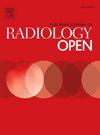基于冠状动脉计算机断层血管造影的不同冠状动脉周围脂肪组织放射组学机器学习模型预测斑块进展
IF 1.8
Q3 RADIOLOGY, NUCLEAR MEDICINE & MEDICAL IMAGING
引用次数: 0
摘要
目的建立并验证基于冠状动脉ct血管造影(CCTA)的不同冠状动脉周围脂肪组织(PCAT)放射组学机器学习模型在预测冠状动脉斑块进展(PP)方面的价值。方法本回顾性研究评估了连续行CCTA检查的97例患者(127个斑块:40例进展性,87例非进展性)。我们分析了常规参数和PCAT放射组学特征。使用逻辑回归(LR)、k近邻(KNN)和随机森林(RF)构建PCAT放射组学模型。采用Logistic回归分析识别变量,建立常规参数模型。通过曲线下面积(AUC)、准确性、灵敏度和特异性等指标评估模型的性能。结果在基线CCTA中提取了93个放射组学特征。经过降维和特征选择,两个放射组学特征被认为是有价值的。在放射组学模型中,我们选择射频作为训练集和验证集的最优模型(AUC = 0.971, 0.821)。在随访CCTA时,logistic回归分析显示,脂肪衰减指数(FAI)升高和PCAT体积减小是PP的独立预测因子,在训练集和验证集中,联合模型(FAI升高+ PCAT体积减小)的预测能力最好(AUC = 0.907, 0.882)。结论在基线CCTA中,基于rf的PCAT放射组学模型对PP具有出色的预测能力。此外,在后续CCTA中,我们的结果表明FAI的增加和PCAT体积的减少都可以独立预测PP,并且它们的组合增强了预测能力。本文章由计算机程序翻译,如有差异,请以英文原文为准。
Prediction of plaque progression using different machine learning models of pericoronary adipose tissue radiomics based on coronary computed tomography angiography
Objectives
To develop and validate the value of different machine learning models of pericoronary adipose tissue (PCAT) radiomics based on coronary computed tomography angiography (CCTA) for predicting coronary plaque progression (PP).
Methods
This retrospective study evaluated 97 consecutive patients (with 127 plaques: 40 progressive and 87 nonprogressive) who underwent serial CCTA examinations. We analyzed conventional parameters and PCAT radiomics features. PCAT radiomics models were constructed using logistic regression (LR), K-nearest neighbors (KNN), and random forest (RF). Logistic regression analysis was applied to identify variables for developing conventional parameter models. Model performances were assessed by metrics including area under the curve (AUC), accuracy, sensitivity, and specificity.
Results
At baseline CCTA, 93 radiomics features were extracted from CCTA images. After dimensionality reduction and feature selection, two radiomics features were deemed valuable. Among radiomics models, we selected the RF as the optimal model in the training and validation sets (AUC = 0.971, 0.821). At follow-up CCTA, logistic regression analysis showed that increase in fat attenuation index (FAI) and decrease in PCAT volume were independent predictors of PP. The predictive capability of the combined model (increase in FAI + decrease in PCAT volume) was the best in the training and validation sets (AUC = 0.907, 0.882).
Conclusions
At baseline CCTA, the RF-based PCAT radiomics model demonstrated excellent predictive ability for PP. Furthermore, at follow-up CCTA, our results indicated that both increase in FAI and decrease in PCAT volume can independently predict PP, and their combination provided enhanced predictive ability.
求助全文
通过发布文献求助,成功后即可免费获取论文全文。
去求助
来源期刊

European Journal of Radiology Open
Medicine-Radiology, Nuclear Medicine and Imaging
CiteScore
4.10
自引率
5.00%
发文量
55
审稿时长
51 days
 求助内容:
求助内容: 应助结果提醒方式:
应助结果提醒方式:


